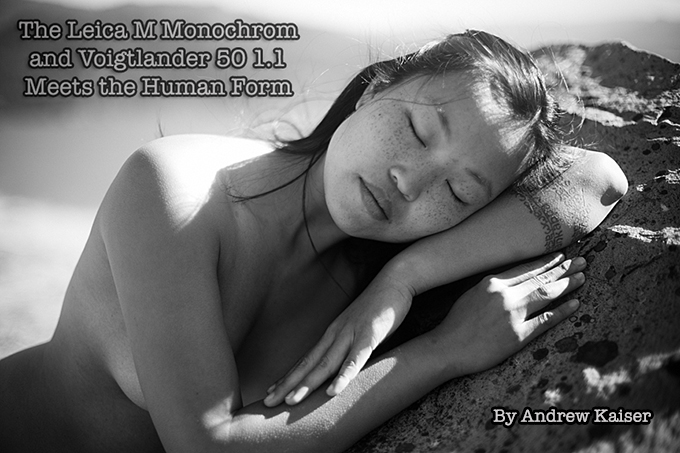
The Leica M Monochrome and the Nokton 50mm F/1.1
Meets the Human Form
By Andrew Kaiser
ATTN: This post contains artistic tasteful Nudity. If you are offended by this or at work you may want to wait until later to read.
UPDATE: Due to a complaint, Google found the tasteful nudity offensive and threatened to shut off my Adsense acct, which is how this site earns its money to keep on going. I had to remove 3 of the photos here, sorry. Always amazed at those who are so ashamed of the human form and see nudity as dirty or offensive. We came into this earth naked, it is who we are, how can anyone be offended with that? Sorry Andrew. Your work is beautiful.
Leica M cameras are often described as the ideal “street” cameras. They are relatively small, fully manual, fast, discreet, durable, and afford photographers the opportunity to work with a treasure trove of quality glass spanning decades of photographic innovation. I can’t say I disagree with any of those attributes and they are one of the primary reasons I was drawn to giving the Leica M Monochrome a try. Strange thing is though, I am not a street photographer. I do however dedicate a very large portion of my work to the human figure and when working outdoors with models baring it all, having a small, fully manual, discreet, and durable camera comes in quite handy as well!
Now before I go too deep into this review I will give full disclosure and say that I primarily work with film. Even though I have quickly fallen in love with the Leica MM I don’t see that as changing anytime soon. That being said I have always hated the “film vs. digital” debate and have considered it one of the most ridiculous arguments in the entire pantheon of artistic history. In the same way that the world is big enough for both electric and acoustic guitars, oil paints and pastels, and wood working and bronze sculptures – the image making community can make room for both analogue and digital mediums. I only bring up my preference for film because one of the things that keeps me going back to that medium is the simple fact that film cameras can often be a more intuitive user experience. I mean lets face it, as camera designers try to pack more and more features (some would say gimmicks) into their latest offerings the more and more it feels like one is taking a picture with a computer as opposed to a simple light capturing device. Sometimes the zen of photography comes from simplicity.
The Leica M series is one of the few digital camera systems on the market which still adopts this philosophy. But hey. I could rant about that forever so let’s get back to talking about the Leica MM specifically. So where was I? Oh yes, discreet, durable, small… In my line of work speed and subtlety are incredibly important. I simply cannot afford to be fussing with camera settings while my model is exposed to wind and rain and the ever-present possibility of onlookers who may be offended by nudity, or worse, the random passerby reaching for their camera phone ecstatic about the free peep show they’ve stumbled upon. The Leica MM works perfectly under these conditions. When I bring the camera up to eye level it is ready to go instantly. The all black body looks completely unassuming from a distance and its whisper like operation means I can work in silence and not break the rapport I have with the model, or attract unwanted attention. Even when working in remote forests and obscure locations I need to get in, set up my shot, and get out quickly. There just simply is no better camera on the market that embodies these characteristics quite like the Leica M series.
Now to the question everyone asks when they find out I own a Leica MM – what is it like working with a black and white only camera? To tell the truth I don’t miss the ability to work with color at all. With film I am using black and white stock about 95% of the time so I suppose you could say I am a die-hard black and white enthusiast. Just the kind of photographer Leica marketed the MM toward. I am drawn to the way the human figure is rendered in black and white, minimizing complex and unique people into simple shapes and forms. The nude is a perfect fit for the abstract nature of black and white photography. The digital files produced by the Leica MM are exactly what I typically aim for when shooting black and white negative film. In other words, yes they do tend to be on the flat side. However, this is not a bad thing! A neutral RAW file is exactly what I want from the camera as it gives me the latitude necessary to toy with my images to get the final tone and vibe I am looking for. Working with MM files in post really feels like printing negatives in a darkroom, or at least as close to working with a digital file ever could be to a chemical work flow.
Since purchasing the MM my favorite lens to pair it with has been the Voigtlander 50mm F/1.1 Nokton. I won’t deny I experienced more anxiety about purchasing the Nokton than any other piece of photographic equipment I own. That is a rather bold statement coming from a guy who shelled out eight grand for digital camera that can’t capture color images. The reason for my hesitation was two-fold. 1) The 50mm f/1.1 Nokton seemed to be a lens that users either loved or hated with equal amounts of vigor. For every goof review of the Nokton it wasn’t hard to find a bad one. Some people described the lens as a godsend compared to the equivalent Leica lens costing ten times the price while others turned their noses up at it claiming it to be lackluster in character and pop. 2) I was nervous about my abilities to accurately focus a rangefinder while utilizing such a thin depth of field.
I mentioned before that I am primarily a film photographer. Surprisingly most of that experience is not with rangefinders but rather with medium format cameras using gigantic waist level finders and ground glass to focus. Compared to that, rangefinders can honestly be a challenge, or at the very least a different way of working that I was not entirely used to. I got over the first problem by telling myself if I hated the lens I could probably turn around and sell it for nearly as much as I bought it for. I pushed past the second problem by just simply sucking in my gut and remembering that practice will always in the end create a better photographer. So far the issue hasn’t been nearly as challenging as I had feared though I have learned even the slightest movement in or out can be the difference between capturing that perfect sweet spot on my subject or instead getting the tip of a model’s nose in perfect focus.
When used wide open at f/1.1 I won’t deny the Nokton can be a bit soft. However, when working with the nude this is not entirely a bad thing. Razor sharp rendering may be great for certain subjects but the human body will often benefit from a more painterly rendering. Or at least, that is what my subjects are always telling me anyway. I have little doubt the lens sharpens up nicely when stopped down but I enjoy using this lens precisely for its dreamy softness and extreme bokeh.
Bokeh is of course one of those things that is purely subjective. Some people find the bokeh on the Nokton to be fairly harsh. I can’t help but feel like those people are making an unfair comparison between the Nokton and the Leica f/0.95 Noctilux. Let’s be clear about something – the Nokton is NOT the Noctilux and considering the Leica lens is ten times the price I would certainly hope not. If it was I would say Leica is ripping people off. The Voigtlander lens is an animal all on its own and there is nothing at all wrong with that.
If my overall impression of the Nokton was that of an imitation Leica lens I would not be happy with it at all.
No, the Nokton renders scenes rather nicely and helps to make your subject pop without feeling too much like a gimick. I like a little “grit” in my photographs, particularly with black and white work and for that the Nokton is perfect. There is a feeling of realism with the Nokton that I really appreciate.
I did learn rather quickly that if you want to work wide open with the Nokton a neutral density filter is pretty much a must have. The native ISO of the MM is 320 and if you want to go lower you will experience a noticeable loss in dynamic range. I have a two stop ND filter parked on the front of my lens nearly all the time when working outdoors and i keep a three stop filter in my bag for when it is really bright (a rarity in Oregon). Thankfully this isn’t too big of a deal. If one is forced to use ND filter I am happy it is with a rangefinder as opposed to an SLR.
In the interest of complete honesty it wouldn’t be fair of me to only talk about the positives of photographing with the MM and the Nokton F/1.1. The biggest drawback by far would be the size of the Nokton. Though it may be considered small on most camera systems, by rangefinder standards it is rather huge. It is so big that the MM feels a tad front heavy when you hold it in your hand and it definitely tilts in a lop sided way when carrying the camera on a shoulder strap. Typically I am carrying the MM in a messanger bag so I can deal with this particular phenominon but for those who carry their Leica’s on a neck strap this is something you may want to consider.
My second criticism has more to do with the MM body. In fact it is the same criticism I have of every Leica M body. It would be incredibly useful if Leica would utilize the same vibration technology that every other manufactuer uses now days to keep dust off the sensor. The Leica M system can arguably utilize the best collection of lenses ever made in the history of photography. It is only natural for M users to change out their lenses a lot, not to mention use their M cameras in dusty dirty environments. In my experience the automatic sensor vibration used by Sony, Canon, Nikon, etc. works wonderfully to keep little dirt particles off the sensor effectively cutting down on the need to get your camera cleaned on a regular basis. Thankfully this hasn’t been an issue yet but I have little doubt it is only a matter of time before the sensor gets dirty.
But hey, no camera is perfect, not even a Leica. All-in-all I am quite happy with my little black beauty!
If you are interested in following my work you can find my website at: www.absoluterealitystudios.com
For my most recent work be sure to check out my blog at: www.absoluterealitystudios.blogspot.com
———————–
From Steve: Don’t forget the latest contest at I-SHOT-IT.com where the grand prize is a Leica Monochrom plus Cash. Check it out here. Deadline is 21 more days! The last winner camera from this website and won the camera plus over $20k in cash.

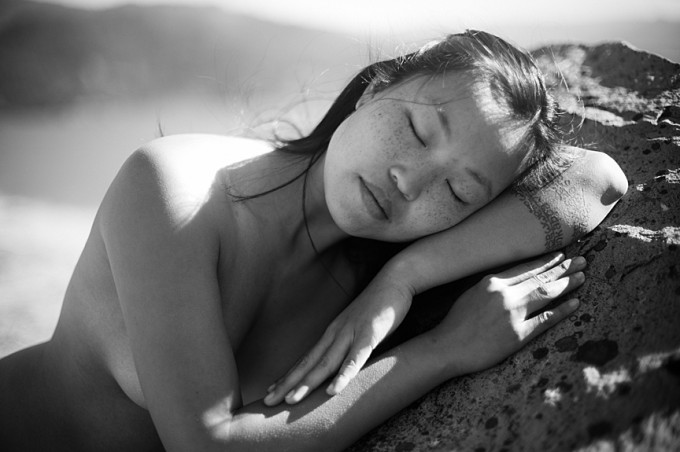
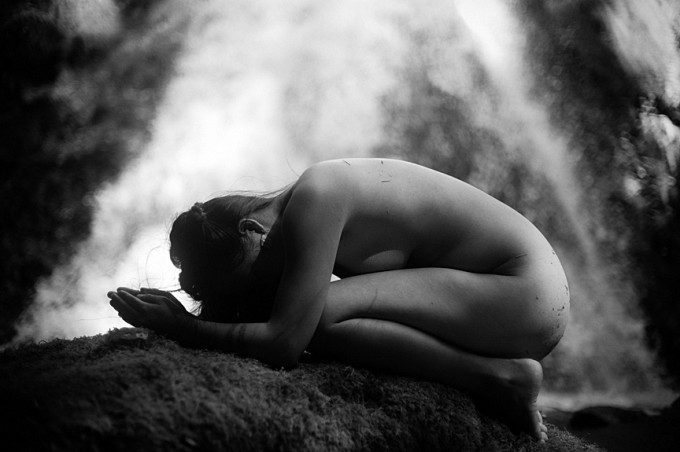
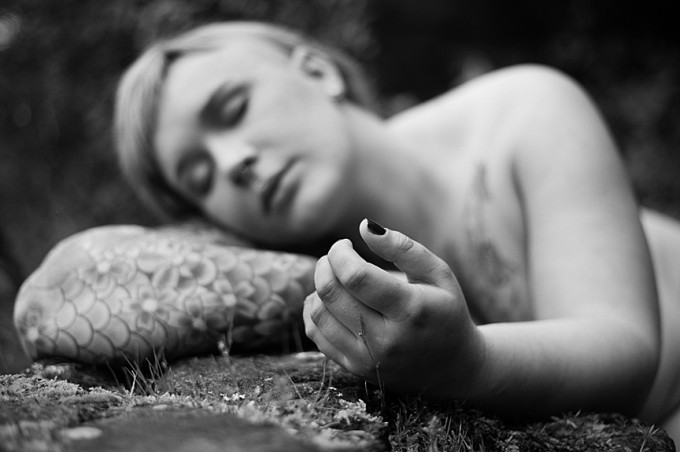
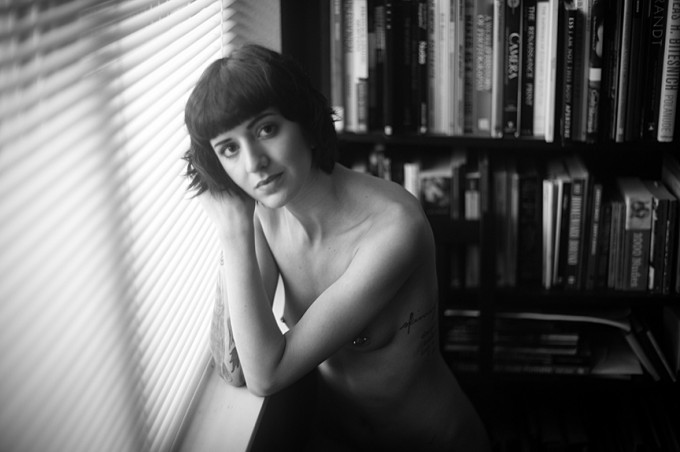


Lens aside, your work here is simply beautiful and gentle. I once purchased the Nokton and returned it. I used it on a Leica M8. I’m now shooting with the MM and considering giving it another try.
Firstly, the photos are stunning examples of how to do nudes. Beauty and the person comes through.
I agree that in anything like bright light with the nokton you need a ND filter — I have a vario ND tiler in my camera bag at all times.
And the lens really works well with Black and Whilte. Admittedly, mine is on an M6…
Great photos, excellent article. I think #3 would have been more powerful if the focus was on the tattoo rather than the hand. Just my opinion. Did you use any filters (other than ND) or apply filters during post processing?
Thanks for the feedback!
In the case of the pictures in the article I did not, though every single one of them I did have the ND filter on the lens.
That being said, I do apply filters at times with the MM. Typically it will be a yellow filter just to get a little more pop and separation between the model and whatever the background may be.
This is photography! Wonderful!
Steve please don´t delete the comments . I said that you had a bad reaction and that is true
Fantastic captures!
An excellent demonstration of the MM with a great lens. Good use of depth of field without going crazy. Remember that Herb Ritts rarely used shallow depth of field yet his photos were some of the best ever done of the female form.
I especially like the model Veronica, she has a very nice form and ‘natural’ real look.
Thank God for a ‘real’ woman!
Yes! Tits!!
Boobies!
Very nice rendering, film like. Nr 1 is my favorite.
Really beautiful photos, clever text.
Thanks for the wonderful photos! The weather must be very cold when you took the first photo, I think I saw goose bumps! 😉
Ha! well here in the Pacific Northwest if there is sunshine that also typically means there is wind blowing all the clouds away 🙂
Especially the freckles girl, iconic!
Beautiful work! Love the way the images are rendered with the Nokton and MM. Anyone I would not feel comfortable showing these to, I wouldn’t want to know.
Beautiful portraits, the lens really isolates the subjects and the out of focus areas are quite creamy.
Some pictures look like semi porn maybe with some shadows could be art
4/10
You must have a distorted view of the human body or be so uptight that any form of nudity, even artistic and beautiful images such as these bother you. These are nothing like porn, none of them, not even close.
Oh my god . ciberbullying ,Steve? It is my opinion please .The pictures don´t bother me .But i know more about this because i am a male model (22 years old) and i have a lot of friends in fashion ,art,etc
They say everyone is entitled to an opinion … But I seriously question that nowadays … Brilliant pics BTW to the original poster. I hope to get close to your level one day.
To change your life change your words !
@Marcus – Just out of curiosity, why wouldn’t everyone be entitled to their opinions? And who gets to decide who is not entitled? You?
Really? That’s the direction you want to take the thread based on an idiotic response? Really? … Not playing. Thanks …
@Gorgic – Man you are funny ! Porn, friends in fashion art !! Comedy…
LOL. Good answer.
Gorgiv, people look like this when they take their close off. Are you ashame of the human body? Haven’t you ever seen anyone naked? And you call this porn!!! You obviously have never seen what real porn looks like.
Interesting… You know often times I worry I rely too much on shadow!!
Porn? LOL!
Congrats, I think this is the most laughable, bigoted, ignorant and pathetic comment I’ve read here. These pictures are completely unsexual.
Speaking of opinions – here’s mine – you’re an ignorant, unaware fool with a cliched view of what is art.
I don’t think its unreasonably for people to link nude adult imagery with sexual emotion. I browsed the associated web site and didn’t see any naked male subjects; or any naked elderly, naked obese, or naked subjects with deformities. Perhaps you should encourage people to divulge their alternate artistic views.
…”Pornography (often abbreviated as “porn” or “porno” in informal usage) (Greek: πορνεία, porneia, fornication) is the explicit portrayal of sexual subject matter for the purpose of sexual gratification”…
From the time of ancient Greece was clear. The mind betrays us…
Great photos. Wonderful B&W.
I think most of the bad reviews this lens gets is because of the competition. It might have its flaws but it still renders nicely to the eye and that is what matters.
I totally agree. Now that I own the lens I think a lot of the criticism is due to completely unrealistic expectations.
I’m curious why you didn’t prefer one of the Leica 50mm lenses rather than or as well as the Nokton, especially if you were worried about focus, etc.
Hi there
Thank you for the comment. I do own one other M mount 50mm which is the Zeiss f/2 Planar. I like that lens quite a bit as well but I think the Nokton is a bit more interesting for nudes and portraits thanks to its dreamy qualities.
Some really beautiful and striking work. So nice to see quality nude photography. The lens and camera do render the subject beautifully but most of the kudos must go to the photographer (and the models).
Awesome pictures. You have a great eye. Keep doing what you’re doing and thank you for letting us into your art.
Awesome!